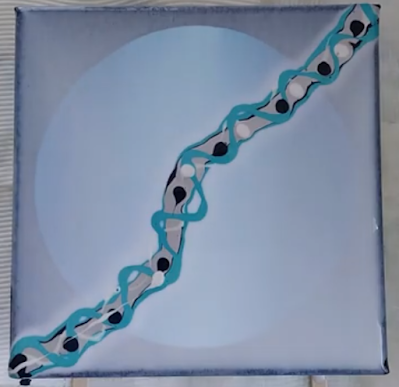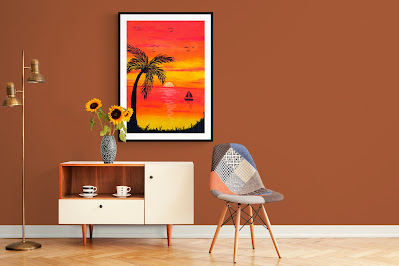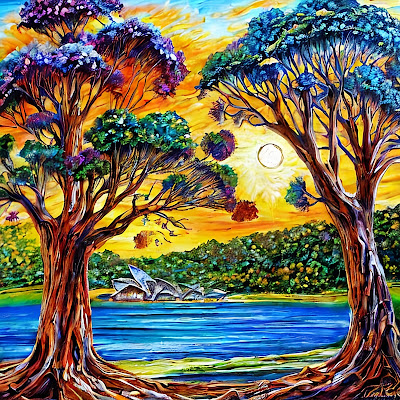Image created by Artificial Intelligence
A new form of art is starting to emerge and it is one that is
beginning to show signs of a future in which it will drastically change
the way people make and appreciate art. This new form of art is AI art,
or art that is created using artificial intelligence.
AI art is still in its infancy, but there are already some impressive
examples of what it is capable of. For instance, a recent program called
"Placeholder" was able to create images that were indistinguishable
from those created by human artists.
As AI art continues to develop, it is likely to have a profound effect
on the future of art. For one, it will allow art to be created in a
completely new way. But more importantly, it could change the way we
think about art and its role in our lives.
1. What is AI Art?
AI Art is art created with the help of artificial intelligence. AI
Art generally falls into two categories: art created by AI and art
created with the help of AI.
In the first instance, AI is used to create art, with the machine
learning algorithms creating the artworks on their own. This can be done
in a number of ways, such as through generative adversarial networks,
which pits two algorithms against each other to create images, or
through evolutionary algorithms, which mimic natural selection to
produce images.
In the second instance, AI is used to help humans create art. For
example, an AI system might be used to generate ideas for a painting or
sculpture, or to help an artist create a piece by providing feedback on
their work. AI can also be used to create digital art, using algorithms
to generate images or videos that are then displayed on a screen.
AI Art is a relatively new field, and it is still developing. It is not
yet clear how AI Art will affect the future of art, but it is likely
that it will change the way that art is created and experienced.
2. How will AI Art affect our future of Art?
A common argument against artificial intelligence is that it lacks
creativity- however, as AI technologies have developed, they have begun
to show signs of being able to create original works of art. This raises
the question of how AI art will affect our future of art.
Some believe that AI will have a positive effect on art, by providing
new opportunities for creativity and expression. For example, AI can be
used to create new pigment colors that cannot be found in nature, or to
generate new realistic textures for paintings. AI can also be used to
create entire new genres of art, such as music composed by AI. In
addition, AI can be used to create art that is interactive and
responsive to the viewer, creating a more immersive and personal
experience.
Others believe that AI will have a negative effect on art, as it will
lead to the mass production of artworks, and the devaluation of art
overall. They argue that AI-created art will lack the emotional depth
and humanity that is found in artworks created by humans. In addition,
mass-produced artworks created by AI could lead to job losses in the art
world, as AI technologies begin to replace human artists.
There is no clear answer as to how AI art will affect our future of art.
However, it is clear that AI art will have a significant impact, and
that it has the potential to change the landscape of art as we know it.
3. What are the benefits of AI Art?
There are many benefits to creating art using AI technology. One
benefit is that it can help to create art that is more realistic and
lifelike. This is because AI technology can be used to create art that
is based on real-world data, making it look more realistic.
Another benefit of AI art is that it can help to create art that is
more unique and individual. This is because each piece of AI art is
created using its own algorithms, meaning that no two pieces will be
exactly the same. This can help to create a more personal and unique art
experience for artists.
Finally, AI art can help to create art that is more interactive and
engaging. This is because AI technology can be used to create art that
responds to viewer interaction. For example, an AI-created painting
could change color or shape based on how the viewer interacts with it.
This type of interactivity can help to create a more immersive and
enjoyable experience for viewers.
4. What are the challenges of AI Art?
The field of AI art is still in its infancy, which means there are
many challenges that still need to be addressed. One of the biggest
challenges is understanding how AI creates art. Currently, there is no
agreed-upon definition of AI art, which makes it difficult to study and
compare AI artworks. Another challenge is that AI artworks are often
created by algorithms that are not transparent, making it difficult to
assess their artistic merits.
Another challenge is that AI art is often created for commercial or
technological reasons, rather than for artistic reasons. This can make
AI artworks seem shallow or impersonal. Finally, the field of AI art is
still evolving, which means that there are likely to be many more
challenges that we have not yet even considered.
5. How can we create AI Art?
We can create AI Art by using a computer program to generate or
create art. This can be done by using an AI algorithm to generate new
art, or by using a computer to mimic the style of an artist.
Some people believe that AI Art is a form of art that is created by a
machine, without any human input. Others believe that AI Art is a form
of art that is created by humans, with the aid of a machine.
Another benefit of creating AI Art is that it can help us to understand
the art of an artist. This can be done by using a computer to mimic the
style of an artist, or by using a computer to generate new art.
Lastly, creating AI Art can help us to appreciate art in a new way. This
can be done by using a computer to generate new art, or by using a
computer to mimic the style of an artist.
Artificial intelligence has the potential to redefine how art is
created and experienced. While some people may fear that AI will lead to
the loss of jobs in the creative industries, it is more likely that AI
will create new opportunities for artists and art lovers alike. By
providing new ways to create and interact with art, AI will help to
broaden our understanding and appreciation of art. In the future, AI
will become an increasingly important tool for artists, as it will allow
them to create new and innovative works of art.
On the internet, there are many websites now where you can join
and create AI Art using prompts that you create. Some of them which are
worth looking at are:-
Lexica Art
CF Spark (Creative Fabrica)
Nightcafe
MidJourney
For a more detailed list click here → Futurepedia.io
Image created by Artificial Intelligence
Conclusion
My thoughts on AI Art! Artists who believe
their work is being stolen by AI have expressed strong opposition. It's a
valid concern. To put it simply, AI employs deep learning techniques to
sample the world through data input. These samples are used to create
the art they create. But, in my opinion, this is no different from the
process that humans have used for thousands of years.
It could be argued that no art is unique. That everything we make
is inspired, imitated, or copied. We are born with the ability to
sample the world around us and use that knowledge to express ourselves
through our imagination.
Cubism, for example, was developed in the early 1900s by Pablo
Picasso and Georges Braque. A painting style that is still imitated
today. Andres Valencia, a ten-year-old, sells his cubism works for six
figures. Nobody believes his art has been stolen.
The fact that AI performs the same process that humans have
developed, albeit at a significantly higher level of efficiency, is why
we should embrace rather than reject the technology.
Art will always be recognized for the effort that it takes to
create it. I've always liked the idea that art is never completed, only
abandoned. And, while "prompt crafting" is a new skill that must be
practiced and developed in order to achieve desired results with AI, I
don't believe that purely generated AI works should win prizes in an art
competition intended to measure human skill and effort.
I do, however, believe that AI is a fantastic tool for artists to
use if they choose to embrace it. The same could be said about digital
painting when artists first had the ability to create "paintings" in a
fraction of the time using a digital pen and Photoshop or the many other
varieties now out there.
Please enjoy below some more images created by Artificial Intelligence.
Please check out all my socials here → My Fluid Art Journey












































